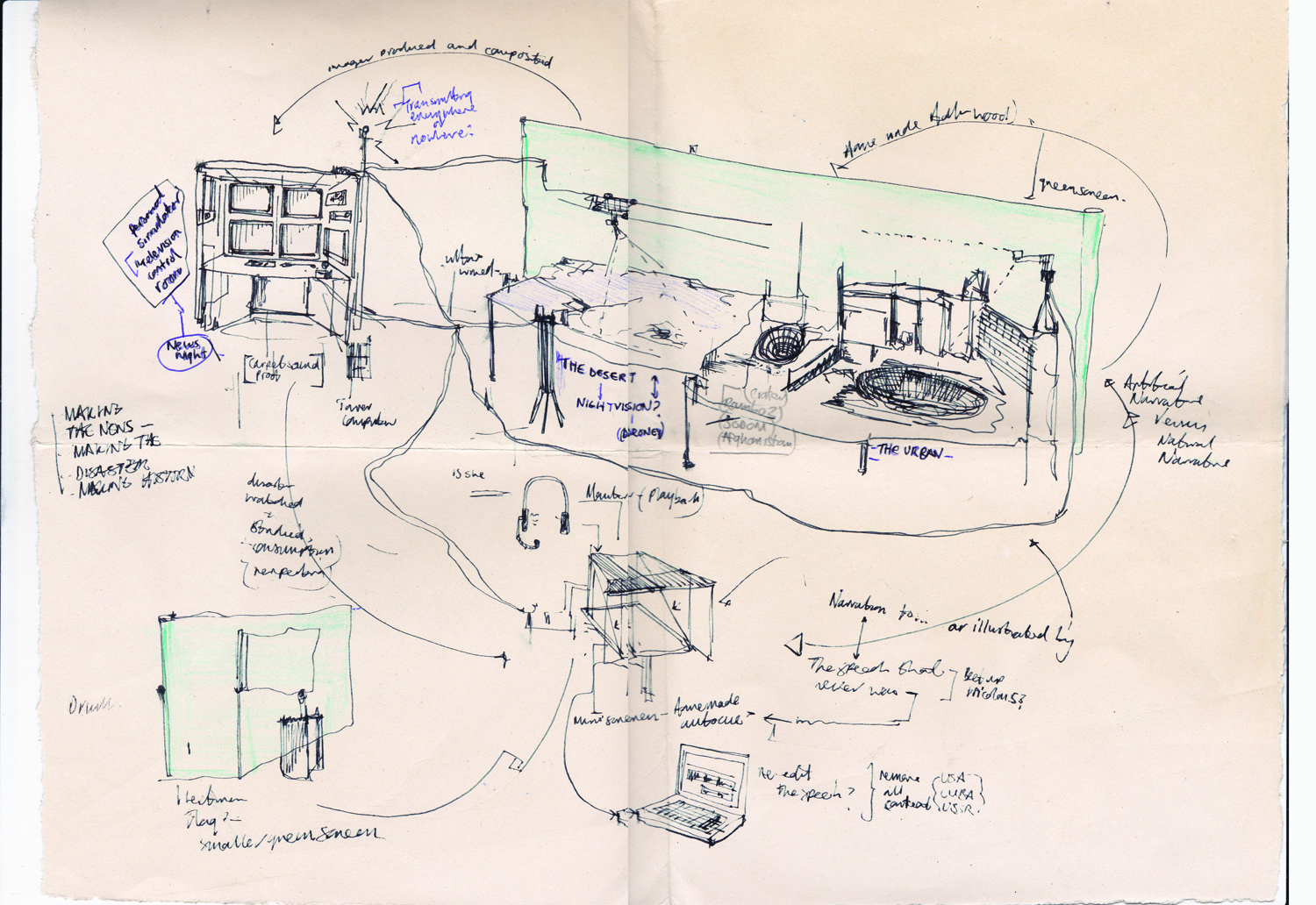Reality testing / Testing Reality -
Originally written for the 'Duty to Act' Film Catalogue
An aspiring television editor, film maker or spokesperson plays out a once plausible world event within an amateur media centre – 'Duty to Act' is a film which considers the construction, delivery and reception of media imagery, and the ability to create versions of reality in a variety of ways.
Blending a counterfactual history with a speculative obsession, the protagonist acts out a variety of roles, each considering the complex nature of role playing and re-enactment. An undelivered speech, written for John F Kennedy to announce the bombing of Cuba in 1962, forms the starting point for three performative actions - the composition of pseudo-television news imagery scale model filming, and the recital of a pre-emptive, Presidential address.
In Today’s post-digital society we are all aware of the increasing ability to gather and distribute information and the consequences of a round the clock commentary on current affairs. This expansion allows us to distribute our opinions and add to the wider conversation, yet the uncanny ability for this to create new roles to mediate a personal propaganda is far more complex than a simple form of communication.
During the research process for this film, many areas of cultural and social history were considered, paying particular attention to the mechanisms involved in political theatre and the illusion of the moving image. The political arena relies heavily on a well crafted and highly developed form of storytelling, with carefully planned photo opportunities and high budget productions which are designed for our screens.[1]
The increasing amount of news commentary that saturates mass communications has always relied on and made use of advances in communications technology. In recent years the role of the public to provide accounts of events has morphed from the eye witness to the video clip, which provides evidence not only of the event but also the instantaneous nature of informational delivery. The impact that self-publishing has had extends further than a greater access to knowledge or insight; it has also changed the way in which we relate to the aesthetics of news media,[2] and provided multiple platforms for good or bad publicity. Alongside these changes, our dependence on visual modes of communication have been altered by the knowledge, ability and understanding of the illusion of the screen, which has undone the beliefs once held that the ‘image never lies’.
‘Duty to Act’ shows a hobbyist’s response to the world of broadcast television and past cinematic techniques married with a domesticated DIY pursuit that reflects on today’s implosion of socially mediated news casting. We are witness to a confused interpretation of the production and consumption of personal and mass media, forming a cyclical and closed system in an anonymous living room. The historically loaded script becomes a document that examines the role of rhetoric and political speeches as a form of linguistic technology, something which aids the design of ideologies, emotions and culture.
With our changing relationship to a media environment that sees art imitate life, and vice versa,[3] our understanding of reality is in reference to a vast array of fictional scenarios, persuasive techniques and the careful translation of real world events. ‘Duty to Act’ is a layered approach to representing the ambivalence found in real life news events and their fictional counterparts. By constructing a character who presents an elaborate set of simulations, an overloaded environment emerges that questions our relationship to the projections of fact and fiction, in addition to interpretations of current issues surrounding the politics of terror attacks and their management in all media.
[1] See page __ Research highlights)The media department for the White House operate as ‘visual story tellers’ to the President, most notably, Scott Sforza - who managed the media image of George W. Bush, and constructed many large scale media events. The Mission accomplished Speech of 2003 was perhaps a highlight of this directorial role, where the President landed on board the USS Abraham Lincoln, wearing a flight suit and greeted by a huge banner reading ‘Mission Accomplished’. The use of an aircraft carrier as the stage for a televised event, shows the extent of real life situations created for ‘the media’ to enhance political ideals.
[2] The video taped messages that Osama Bin Laden recorded and distributed via news channels are one example of a subversion of the once nostalgic aesthetic of home movies. The importance of these video messages functioned with a dual purpose, not only did they act as publicity and propaganda for a terrorist organisation, but provided the west with a ‘super villain’ character who’s existence as a screen based mastermind of terror could be easily manipulated. More recently, the Murder of Lee Rigby in Woolwich London,was a radicalised attack that was reported to have been willingly filmed, the perpetrators using the onlooking camera-phones as their immediate distribution for their horrifying message of politically motivated brutality.
[3] (See page __ research highlights - )One case of two-way imitation is the character of Matthew Santos in the television drama ‘The West Wing’ as the design of aspects of his character were modelled on senator Barack Obama, who at the time was gaining popularity as a new force in the democratic party. It could be argued that television drama has the ability to perform a sort of social priming by introducing ideas that challenge social norms. The continuing power of simulation and spectacle works as a dual function by supporting real world notions of change, and providing the story-lines for primetime television.



